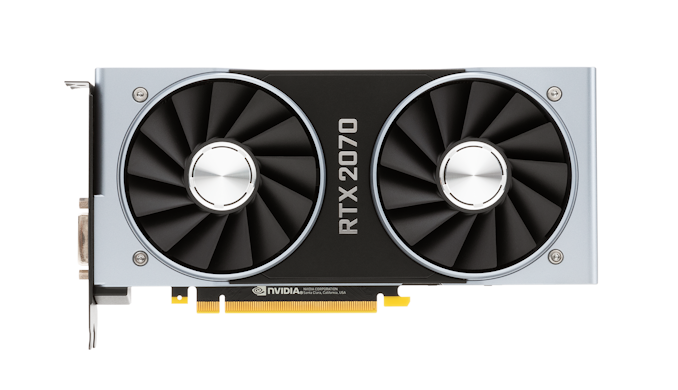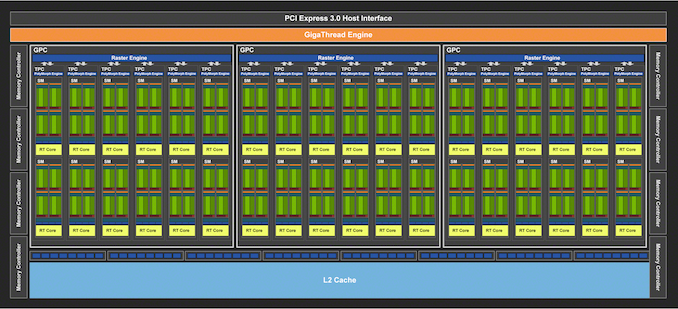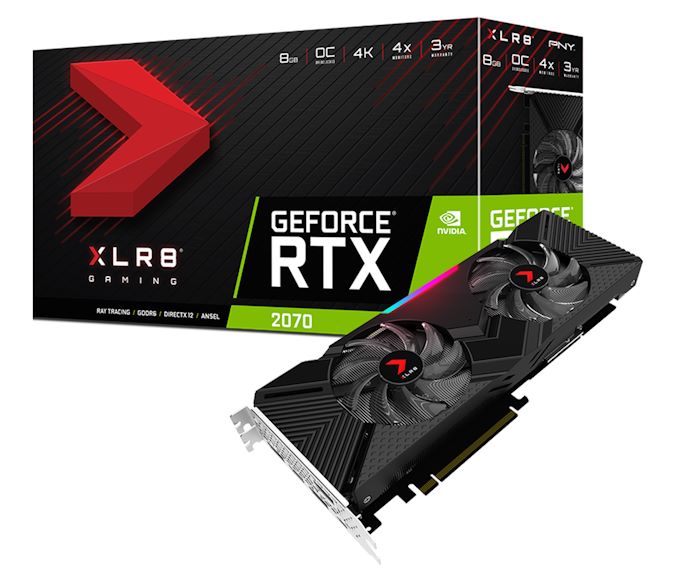The NVIDIA GeForce RTX 2070 Founders Edition Review: Mid-Range Turing, High-End Price
by Nate Oh on October 16, 2018 9:00 AM EST
When NVIDIA first announced their Turing based GeForce RTX 20 series, they unveiled three GeForce RTX models: the 2080 Ti, 2080, and 2070. As we’ve seen earlier, Turing and the GeForce RTX 20 series as a whole are designed on a hardware and software level to enable realtime raytracing for games, as well as other new specialized features, though all of these are yet to launch in games. Nevertheless, last month’s release of the GeForce RTX 2080 Ti and 2080 finally revealed their places on the traditional performance spectrum. As the ‘value’ oriented enthusiast offering, the RTX 2070 is arguably the more important card for most prospective buyers. And so, ahead of tomorrow’s launch, today we take a look at the GeForce RTX 2070 Founders Edition.
Even as the value option, which is historically the case for the x70 part, the RTX 2070 Founders Edition comes in at $599, with standard MSRP at $499. For all intents and purposes, the lower $499 price won’t be seen in the near-future as AIBs will be aligned with NVIDIA to avoid cannibalization and lower ASPs. Either way, the $500 mark makes it clear that ‘value’ and ‘cheap’ don’t necessarily mean the same thing.
| NVIDIA GeForce Specification Comparison | ||||||
| RTX 2070 Founder's Edition |
RTX 2070 | GTX 1070 | RTX 2080 | |||
| CUDA Cores | 2304 | 2304 | 1920 | 2944 | ||
| ROPs | 64 | 64 | 64 | 64 | ||
| Core Clock | 1410MHz | 1410MHz | 1506MHz | 1515MHz | ||
| Boost Clock | 1710MHz | 1620MHz | 1683MHz | 1710MHz FE: 1800MHz |
||
| Memory Clock | 14Gbps GDDR6 | 14Gbps GDDR6 | 8Gbps GDDR5 | 14Gbps GDDR6 | ||
| Memory Bus Width | 256-bit | 256-bit | 256-bit | 256-bit | ||
| VRAM | 8GB | 8GB | 8GB | 8GB | ||
| Single Precision Perf. | 7.9 TFLOPs | 7.5 TFLOPs | 6.5 TFLOPs | 10.1 TFLOPs | ||
| "RTX-OPS" | 45T | 45T | N/A | 60T | ||
| SLI Support | No | No | Yes | Yes | ||
| TDP | 185W | 175W | 150W | 215W FE: 225W |
||
| GPU | TU106 | TU106 | GP104 | TU104 | ||
| Transistor Count | 10.8B | 10.8B | 7.2B | 13.6B | ||
| Architecture | Turing | Turing | Pascal | Turing | ||
| Manufacturing Process | TSMC 12nm "FFN" | TSMC 12nm "FFN" | TSMC 16nm | TSMC 12nm "FFN" | ||
| Launch Date | 10/17/2018 | N/A | 06/10/2016 | 09/20/2018 | ||
| Launch Price | $599 | $499 | MSRP: $379 Founders $449 |
MSRP: $699 Founders $799 |
||
For the RTX 2070, its value would be measured by both traditional rasterization performance, and hybrid rendering performance. For the former, the GeForce GTX 1080 sits at the $500 price point, so that is very much the card to beat, with the AMD Radeon Vega 64 and GeForce GTX 1070 Ti also offering similar levels of performance. Beating the GTX 1080 by a significant margin will in turn offer more to those still on older generation cards like the GTX 970 & 980. But trading blows with the GTX 1080 would leave the RTX 2070 in a situation where it is priced higher with less availability for equivalent traditional performance. As an aside, HDR presents a wrinkle where the RTX 20 series incurs less of a performance hit, but the difference varies per game and only a selection of games support HDR in the first place.
Unfortunately, accurate hybrid rendering performance remains somewhat of a mystery. Games have yet to bring support for RTX platform features, and additionally DXR itself is only just starting to rollout as part of Windows 10 October 2018 Update (1809), itself delayed due to data-loss issues. RTX platform features like realtime ray tracing and DLSS come at a steep cost; currently, the RTX 2080 Ti stands at $1200 and the RTX 2080 at $800, and now with the $600 RTX 2070 as the entry card for those features. So for gamers interested in using realtime ray tracing, it's still unclear what we should expect as far as real-world hybrid rendering performance is concerned; in any case, the RTX 2070 does not support SLI, which precludes a future mGPU drop-in upgrade. That is to say, if the RTX 2070’s real time ray tracing performance target for resolution/framerate is significantly lower than the RTX 2080 Ti or 2080, there won’t be an easy solution in the form of doubling up 2070s.
In any case, the RTX 2070 is built on its own GPU, TU106, rather than being a cut-down version of TU104, and by the numbers offers 75% of the RTX 2080’s shading/texturing/tensor resources with the same ROP count and 256-bit memory bus. Considering the SM-heavy nature of ray tracing workloads, it would be interesting to investigate once real time ray tracing and DXR is fully released to the public in production-ready in games.
But as a straight upgrade, the RTX 2070 is in a delicate situation. What we know already is where the RTX 2080 Ti and RTX 2080 lie in terms of conventional gaming performance; the RTX 2080 Ti is roundabouts the Titan V, while the RTX 2080 is comparable to the Titan Xp and GTX 1080 Ti. As the top two performing cards of the stack, there’s some natural leeway with premiums, but the RTX 2070 does not have that luxury as the x70 part, and will be right in the mix of Pascal with the GTX 1080 and GTX 1070 Ti in the $450 to $600 range, along with GTX 1080 Ti models at the $700 mark. The GTX 1080s priced at $490 could act as a significant spoiler if there are issues with launch inventory, which has already caused delays in the RTX 2080 Ti.
Beyond that, the biggest open questions are all about the RTX platform features like realtime ray tracing and DLSS. Gamers considering making the plunge will be looking at the RTX 2070 as the entry point, but right now there is no accurate and generalizable way to determine what that entry level performance would look like in the real world.
| Fall 2018 GPU Pricing Comparison | |||||
| AMD | Price | NVIDIA | |||
| $1199 | GeForce RTX 2080 Ti | ||||
| $799 | GeForce RTX 2080 | ||||
| $709 | GeForce GTX 1080 Ti | ||||
| $599 | GeForce RTX 2070 | ||||
| Radeon RX Vega 64 | $569 | ||||
| Radeon RX Vega 56 | $489 | GeForce GTX 1080 | |||
| $449 | GeForce GTX 1070 Ti | ||||
| $399 | GeForce GTX 1070 | ||||
| Radeon RX 580 (8GB) | $269/$279 | GeForce GTX 1060 6GB (1280 cores) |
|||












121 Comments
View All Comments
PeachNCream - Tuesday, October 16, 2018 - link
You've got a good graphics card in the 970 that should get you at least a couple more years of reasonable performance. If I were in your position, I wouldn't be in the market for a new GPU. However, I do sympathize with you when it comes to the cost it takes to be able to play these days and I agree that a shift to some form of console is a sensible alternative. PC hardware pricing has been on the rise in the last few years and it stings when you've come to expect performance improvements alongside cost reductions that we've been enjoying for the majority of the years since microcomputers found their way into homes in the 1980s.I think what's driving that is a diminishing market. Economies of scale don't work when there's no further growth for what's become a mature industry (PCs in general) and a declining segment (desktop PCs in specific) due to the slow shift of computing tasks to mobile phones. I don't see anywhere for desktop components to go but further up as we lean into the physical limits of the materials we have available while also contending with falling sales numbers. Compound that with the damage these prices will inflict on the appeal of PC gaming to the masses and we're starting to look at a heck of an ugly snowball on its way down the hill.
It's probably a good time to make a graceful exit like you're mulling over now. As someone else that's thrown in the towel, I can happily confirm there's lots of fun to be had on very modest, inexpensive hardware. From older games to low system requirements new releases, I have faith that there will always be a way to burn up a lot of free time at a keyboard even if you end up with very old, very cheap hardware.
WarlockOfOz - Wednesday, October 17, 2018 - link
Concur. I'm still rocking a 750Ti and feeling no need to upgrade it or the even older CPU (phenom x4) despite having money put aside. I'll replace when it breaks, like my fridge, unless something does make going past 1080p compelling - whether that's VR, ray tracing, or a must have game that I can't play at all.nikon133 - Tuesday, October 16, 2018 - link
I hear you.Been considering to make my current rig - older i7 (Haswel) with recently added 1070 - my last gaming PC. It really boils down to how next gen consoles turn out - but even as current gen is, I seem to be spending more time on PS4 than on gaming PC. In fact, MHW is the only game I am playing on PC atm, and event hat because of friends who insisted to play it on PC. Eventually, we are lucky if we get to play it together once a week, on average... definitely not worth investment into new rig, for me.
ingwe - Wednesday, October 17, 2018 - link
I mean you don't need the most top end or recent parts. I am gaming on a 5850 and i5-4670K (I think that is the model it has been so long I might be mixing things up). It runs great. 256 GB SSD and 16 GB of ram.The prices are crazy for the high end but you also don't need the highest end and most recent gen when performance improvements are marginal.
Farfolomew - Monday, October 22, 2018 - link
In the 486 days, computer gaming was worth that much money. The landscape was rapidly changing, games were rapidly changing. The internet was taking hold, 3D gfx starting to be born. It was amazing. It was money well spent to be able to play groundbreaking new types of games.Nowadays, although overall less expensive perhaps, your money doesn't buy you much new in terms of originality and exciting gameplay. All we get are prettier and prettier textures with duller and duller games. WoW and Counterstrike are STILL massively popular games, certainly not for their gfx.
Eris_Floralia - Tuesday, October 16, 2018 - link
Nate, iirc they handicapped the tensor performance of FP16 with FP32 accumulate, which is only half of those on equivlant Quadro cards, maybe that's why HGEMM performance is low.https://cdn.discordapp.com/attachments/47593159264...
Eris_Floralia - Tuesday, October 16, 2018 - link
*equivalentYojimbo - Tuesday, October 16, 2018 - link
The chart says half precision GEMM. So I think a lack of accelerated 32-bit accumulation should not be slowing the GPU down. As far as I know, the Turing Tensor Cores perform FP16 multiplications with FP16 accumulations at 8 operations per clock much like Volta Tensor Cores perform FP16 mults. with FP32 accumulation at 8 operations per clock.Eris_Floralia - Tuesday, October 16, 2018 - link
Turing FP16 with FP16 accumulate is fully enabled on all RTX cards, but FP16 with FP32 accumulate is 1/2 rate on GeForce cards.They used out of the box configuration which likely used Volta's FP16 with FP32 accumulate, resulting in half the performance.
HGEMM results for 2080TI/2080/2070 are very close to their 54/40/30 TFLOPS theoretical performance. If it was a Quadro card you will see double the performance with this config. If they updated the binary support, you'll likely see double the perf with FP16 accumulate too.
Yojimbo - Tuesday, October 16, 2018 - link
"They used out of the box configuration which likely used Volta's FP16 with FP32 accumulate, resulting in half the performance."It could be some driver error. But I don't see why the GPUs not having FP32 accumulate should be the ultimate cause for the poor results. I admit I don't know much about the test, but why should the test demand FP16 multiplications with FP32 accumulate? That's more or less an experimental situation only available commercially in NVIDIA's hardware, as far as I know. If the test is meant to use FP16 accumulate and FP32 is being forced in the test then the reason for the poor results is a driver or testing error, not that Turing GPUs only have FP16 accumulate at full Tensor Core speed for the precision.